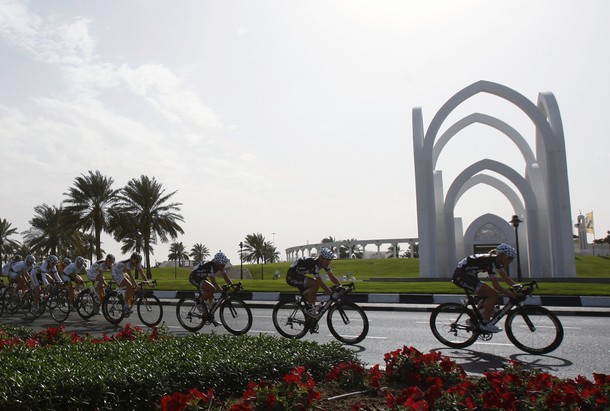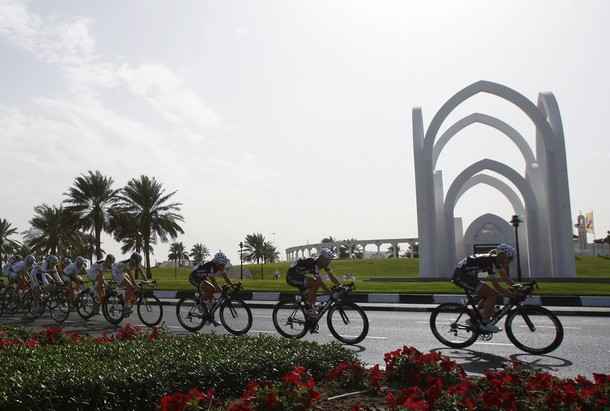In this eleventh part of our continuing series looking at different aspects of the revenue-sharing debate, we continue to consider the reality of revenue sharing as it exists today. Having considered how ASO shares the wealth at their races, today we look at what is happening elsewhere on the calendar.
Last time out we looked at the prize funds on offer at ASO’s races and discovered that only four ASO races – the Tour de France, the Tour of Oman, the Tour of Qatar and the Ladies Tour of Qatar – offer team prizes. Time now to turn to what is happening in the WorldTour as a whole.
|
Table 1: Prize money at WorldTour races (2011) |
|||||
|
Date |
Race |
Organiser |
Location |
Racing Days |
Prizes |
|
18-Jan |
Tour Down Under |
Australia |
6 |
||
|
6-Mar |
Paris-Nice |
ASO/TDF Sport |
France |
8 |
138,400 |
|
9-Mar |
Tirreno-Adriatico |
RCS |
Italy |
7 |
140,000 |
|
19-Mar |
Milano-Sanremo |
RCS |
Italy |
1 |
50,000 |
|
21-Mar |
Volta Ciclista a Catalunya |
Spain |
6 |
||
|
27-Mar |
Gent-Wevelgem |
KVHVW |
Belgium |
1 |
40,000 |
|
3-Apr |
Ronde van Vlaanderen |
RIA |
Belgium |
1 |
50,000 |
|
4-Apr |
Vuelta Ciclista al Pais Vasco |
Spain |
6 |
||
|
10-Apr |
Paris-Roubaix |
ASO/TDF Sport |
France |
1 |
91,000 |
|
17-Apr |
Amstel Gold Race |
Netherlands |
1 |
||
|
20-Apr |
Flèche Wallonne |
ASO/RCPCL |
Belgium |
1 |
45,750 |
|
24-Apr |
Liège-Bastogne-Liège |
ASO/PSO |
Belgium |
1 |
55,750 |
|
26-Apr |
Tour de Romandie |
LFPLCR/TdR |
Switzerland |
6 |
108,000 |
|
7-May |
Giro d’Italia |
RCS |
Italy |
21 |
1,381,010 |
|
5-Jun |
Critérium du Dauphiné |
ASO/TDF Sport |
France |
8 |
120,000 |
|
11-Jun |
Tour de Suisse |
IMG (Schweiz) |
Switzerland |
9 |
166,200 |
|
2-Jul |
Tour de France |
ASO |
France |
21 |
2,021,200 |
|
30-Jul |
Clásica CiclistaSan Sebastian |
Spain |
1 |
||
|
31-Jul |
Tour de Pologne |
Poland |
7 |
||
|
8-Aug |
Eneco Tour |
Eneco/GS |
Netherlands |
7 |
117,700 |
|
20-Aug |
Vuelta a España |
Unipublic |
Spain |
21 |
1,057,480 |
|
21-Aug |
Vattenfall Cyclassics |
Lagardère |
Germany |
1 |
|
|
28-Aug |
GP Ouest France-Plouay |
UCPP |
France |
1 |
40,000 |
|
9-Sep |
Grand Prix Cycliste de Québec |
Canada |
1 |
||
|
11-Sep |
Grand Prix Cycliste de Montréal |
Canada |
1 |
||
|
5-Oct |
Tour ofBeijing |
GCP |
China |
5 |
|
|
15-Oct |
Giro di Lombardia |
RCS |
Italy |
1 |
50,000 |
|
Source: Individual races |
|||||
The first thing you will notice in the above table is that it is incomplete. (So much for research, eh?) Of the 27 WorldTour races, I don’t have prize figures for 10 of them. Prize funds are not covered by the official secrets act. It should be easy to find out how much each race pays out. In fact, you would think most races would want to boast about their generosity, no? For a lot of races – particularly ASO’s – finding the information is easy, it’s just a click away on their websites. For other races though … oh dear.
For those races I couldn’t find the information I was looking for – either on the race’s website, or elsewhere on the net – I emailed the race organisers. Out of about a dozen-and-a-half emails I sent, only two race organisers could be bothered enough to reply. And one of them is still trying to find the information for me. (If any of you want to help fill in the blanks, you can find me on Twitter @fmk_RoI.)
So, my poor research skills aside, what is there to say of the races for which information is available? As per last time out, these figures are before considering participation allowances. If getting basic prize fund information isn’t easy, you can imagine the difficulty in getting participation allowances. The information I have though is that, the Grand Tours aside, only the Tour Down Under and the Tour of Beijing are paying more than the UCI-mandated €7,500 participation allowance (the actual amounts being paid by the Tour Down Under and the Tour of Beijing I don’t have, but it’s somewhere between $20,000 and $40,000 per team).
My real interest here is again in that portion of their prize funds race organisers set aside for teams. Of the above races for which I do have information, just five pay out team prizes: Tierreno-Adriatico (€11,000), the Giro (€118,340), the Tour (€201,000), the Eneco Tour (€1,000) and the Vuelta (€52,000). The Tour we’ve already covered, when looking at ASO’s races. The Giro and the Vuelta, you would expect them to pay team prizes. That Tierreno-Adriatico pays team prizes is not entirely unexpected, given its placement on the calendar. That the Eneco Tour is the only other race paying out a team prize is a surprise. (Again, it’s necessary to stress that there are ten WorldTour race organisers who couldn’t be bothered answering a simple question about how much they pay out in prizes. Some of them may, and probably do, pay team prizes.)
So let’s go back to the question I left hanging last time out: should ASO pay out more to the participating teams? The knee-jerk response is obviously yes. But let’s not be jerks. Rather, we should note that the Tour is already paying out considerably more than its nearest rival, and that ASO are, generally, more generous than most all of their rivals. Rather than demanding more from ASO, shouldn’t the AIGCP be doing more to level the playing field among all the race organisers, make the other races pay out more first?
But what if those other races can’t afford to pay out more? Anecdotal evidence tells us that the Tour de France makes a profit, as does Paris-Roubaix. The tours in Qatar and Oman have rich sugar-daddies. The profitability of the other races is open to question. My own opinion – and it is just that, an opinion – is that ASO is not a charity and would not be running races if there wasn’t a profit in it.
But what of others? Take the GP Ouest France-Plouay. Out of the generosity of their hearts, the good men and women in Aigle who ruin this sport kindly allocated €30,000 from the ProTour reserve to the GP Ouest France-Plouay in 2010, to help meet the increased costs of being on the WorldTour calendar (most of which costs go back into the pocket of the UCI – it’s just like giving aid to Africa, really). Making races pay their way is never easy, as all of us who have been involved in organising them at any level can attest. (It’s also worth recalling that the good men and women in Aigle have also generously used the ProTour reserve to sub Global Cycling Promotions €445,000 in 2010 and €177,000 in 2009. Given that GCP organises just one race, you might see that as a subvention to the Tour of Beijing.)
Does the failure to pay out team prizes mean that those races that don’t can’t afford the extra prize money? Possibly. But, as we saw last time out, even at ASO’s races there’s only four paying team prizes. So how about we consider the size of the overall prize fund and see what that tells us? The UCI sets a minimum prize money figure for different races, which covers stages and GC. Comparing how far ahead of the minimum different races are might offer some guidance as to how flush with cash they are.
Let’s do this in two stages, the first looking just at ASO races, the second looking at WorldTour races.
|
Table 2: Actual prize money compared to minimum at ASO races (2011) |
|||||||
|
Date |
Race |
Organiser |
Cat |
Racing Days |
Minimum |
Actual |
Excess |
| 2-Feb | Tour of Qatar(Ladies) | ASO/QCF |
2.1 |
3 |
4,748 |
18,689 |
13,941 |
| 6-Feb | Tour of Qatar | ASO |
2.1 |
6 |
68,913 |
102,618 |
33,705 |
| 15-Feb | Tour of Oman | ASO/MoM |
2.1 |
6 |
63,027 |
111,642 |
48,615 |
| 6-Mar | Paris-Nice | ASO/TDF Sport |
WT |
8 |
120,000 |
138,400 |
18,400 |
| 26-Mar | Critérium International | ASO/TDF Sport |
2.HC |
2 |
31,835 |
40,088 |
8,254 |
| 10-Apr | Paris-Roubaix | ASO/TDF Sport |
WT |
1 |
50,000 |
91,000 |
41,000 |
| 20-Apr | Flèche Wallonne | ASO/RCPCL |
WT |
1 |
40,000 |
45,750 |
5,750 |
| 20-Apr | Flèche Wallonne Femmes | ASO/RCPCL |
CDM |
1 |
5,130 |
5,130 |
0 |
| 24-Apr | Liège-Bastogne-Liège | ASO/PSO |
WT |
1 |
50,000 |
55,750 |
5,750 |
| 13-May | Tour de Picardie | ASO/TDF Sport |
2.1 |
3 |
34,457 |
41,958 |
7,502 |
| 4-Jun | La Classique des Alpes Juniors | ASO/TDF Sport |
1.1U |
1 |
1,215 |
2,120 |
905 |
| 5-Jun | Critérium du Dauphiné | ASO/TDF Sport |
WT |
8 |
120,000 |
120,000 |
0 |
| 2-Jul | Tour de France | ASO |
WT |
21 |
1,000,000 |
2,021,200 |
1,021,200 |
| 4-Sep | Tour de l’Avenir | ASO |
2.Ncup |
8 |
8,736 |
||
| 9-Oct | Paris-Tours Espoirs | ASO/TDF Sport |
1.2U |
1 |
6,010 |
6,010 |
0 |
| 9-Oct | Paris-Tours* | ASO |
1.HC |
1 |
18,800 |
20,000 |
1,200 |
|
Source: ASO / UCI |
|||||||
What’s interesting here is that there are only three races at which ASO pay the absolute minimum prize money: the Flèche Wallonne Femmes, Paris-Tours Espoirs, and the Critérium du Dauphiné. Of the last, it’s worth remembering that ASO only took over the race last year. So while they can afford to find extra money for riders at most all of their races, they can only afford to find money to reward the teams at four of them. If you were writing their end of term school report, you’d be inclined to put ‘could try harder’ at the bottom of it.
At the WorldTour races, the picture looks like this:
|
Table 3: Actual prize money compared to minimum at WorldTour races (2011) |
|||||||
|
Date |
Race |
Organiser |
Location |
Racing Days |
Minimum |
Actual |
Excess |
|
18-Jan |
Tour Down Under |
Australia |
6 |
90,000 |
|||
|
6-Mar |
Paris-Nice |
ASO/TDF Sport |
France |
8 |
120,000 |
138,400 |
18,400 |
|
9-Mar |
Tirreno-Adriatico |
RCS |
Italy |
7 |
105,000 |
140,000 |
35,000 |
|
19-Mar |
Milano-Sanremo |
RCS |
Italy |
1 |
50,000 |
50,000 |
0 |
|
21-Mar |
Volta Ciclista a Catalunya |
Spain |
6 |
90,000 |
|||
|
27-Mar |
Gent-Wevelgem |
KVHVW |
Belgium |
1 |
40,000 |
40,000 |
0 |
|
3-Apr |
Ronde van Vlaanderen |
RIA |
Belgium |
1 |
50,000 |
50,000 |
0 |
|
4-Apr |
Vuelta Ciclista al Pais Vasco |
Spain |
6 |
90,000 |
|||
|
10-Apr |
Paris-Roubaix |
ASO/TDF Sport |
France |
1 |
50,000 |
91,000 |
41,000 |
|
17-Apr |
Amstel Gold Race |
Netherlands |
1 |
40,000 |
|||
|
20-Apr |
Flèche Wallonne |
ASO/RCPCL |
Belgium |
1 |
40,000 |
45,750 |
5,750 |
|
24-Apr |
Liège-Bastogne-Liège |
ASO/PSO |
Belgium |
1 |
50,000 |
55,750 |
5,750 |
|
26-Apr |
Tour de Romandie |
LFPLCR/TdR |
Switzerland |
6 |
90,000 |
108,000 |
18,000 |
|
7-May |
Giro d’Italia |
RCS |
Italy |
21 |
850,000 |
1,381,010 |
531,010 |
|
5-Jun |
Critérium du Dauphiné |
ASO/TDF Sport |
France |
8 |
120,000 |
120,000 |
0 |
|
11-Jun |
Tour de Suisse |
IMG (Schweiz) |
Switzerland |
9 |
135,000 |
166,200 |
31,200 |
|
2-Jul |
Tour de France |
ASO |
France |
21 |
1,000,000 |
2,021,200 |
1,021,200 |
|
30-Jul |
Clásica Ciclista San Sebastian |
Spain |
1 |
40,000 |
|||
|
31-Jul |
Tour de Pologne |
Poland |
7 |
105,000 |
|||
|
8-Aug |
Eneco Tour |
Eneco/GS |
Netherlands |
7 |
105,000 |
117,700 |
12,700 |
|
20-Aug |
Vuelta a España |
Unipublic |
Spain |
21 |
850,000 |
1,057,480 |
207,480 |
|
21-Aug |
Vattenfall Cyclassics |
Lagardère |
Germany |
1 |
40,000 |
||
|
28-Aug |
GP Ouest France-Plouay |
UCPP |
France |
1 |
40,000 |
40,000 |
0 |
|
9-Sep |
Grand Prix Cycliste de Québec |
Canada |
1 |
40,000 |
|||
|
11-Sep |
Grand Prix Cycliste de Montréal |
Canada |
1 |
40,000 |
|||
|
5-Oct |
Tour ofBeijing |
GCP |
China |
5 |
75,000 |
||
|
15-Oct |
Giro di Lombardia |
RCS |
Italy |
1 |
50,000 |
50,000 |
0 |
|
Source: Individual races / UCI |
|||||||
Of the WorldTour races for which I have information, you can see that 11 are paying above minimum prize money (and almost half of them are ASO events). But remember, just 5 of the above races (for which I have information) pay out team prizes.
There’s a point I’d like to introduce here, but for which I don’t have detailed information. Someone else will pick it up and run with it, perhaps. The point is this: increasingly, race organisers are turning to cyclo-sportifs to help boost their bottom line. Consider the list of World Tour races above and the number of them that have associated cyclo-sportifs. Cyclo-sportifs which feed off pro races. It is easy for some race organisers to put on the poor mouth and argue that they are barely covering their costs in organising pro races. It’s even easier to use accouning sleights of hand to prove this should anyone ever look hard enough. But if race organisers are making money off the back of those races via a cyclo-sporif, then some of that money should, I think, feed back into the pro race. And from there back to the teams (and riders) who make that race popular.
Does any of this help answer the question as to whether the playing field among all the race organisers can be levelled, whether other race organisers should also be called upon to pay out more to the teams? Even without the cyclo-sportif point, I think it does, and that the answer is yes. If race organisers can afford to be generous to the riders, they can afford to be generous to the teams. Even if that means they have to be less generous to the riders. That’s just my opinion, and you’re welcome to disagree with it. And, by the end of the week and the conclusion of this series, I may be disagreeing with it myself.
Focusing the revenue-sharing debate on the richest race on the calendar is obviously the easy thing for the AIGCP to do; it is the story that will gain them the most publicity. But, if you were in ASO and the AIGCP were trying to embarrass you into giving them more crumbs from the table, don’t you think that you’d tell them to get other race organisers to improve their act first? Or maybe you’d want to tell them that, rather than using the media to demand meetings with Marie-Odile Amaury (bypassing the head of ASO, her son, Jean-Étienne Amaury, which is a bit like saying ‘I’ll tell your ma’ when the big boys won’t let you play with them) they should take their problem to the UCI and get them to set minimum prize money for teams and not just for riders?
Next: The CADF and the sharing of costs between teams and race organisers.
Previous: Revenue sharing at ASO races.
















2 Comments
[…] consider how much of the cost of anti-doping the race organisers currently share. As we saw last time out, minimum prize money for WorldTour events varies. For the five monuments – Milano-San Remo, […]
[…] Next: Sharing the wealth at the WorldTour. […]